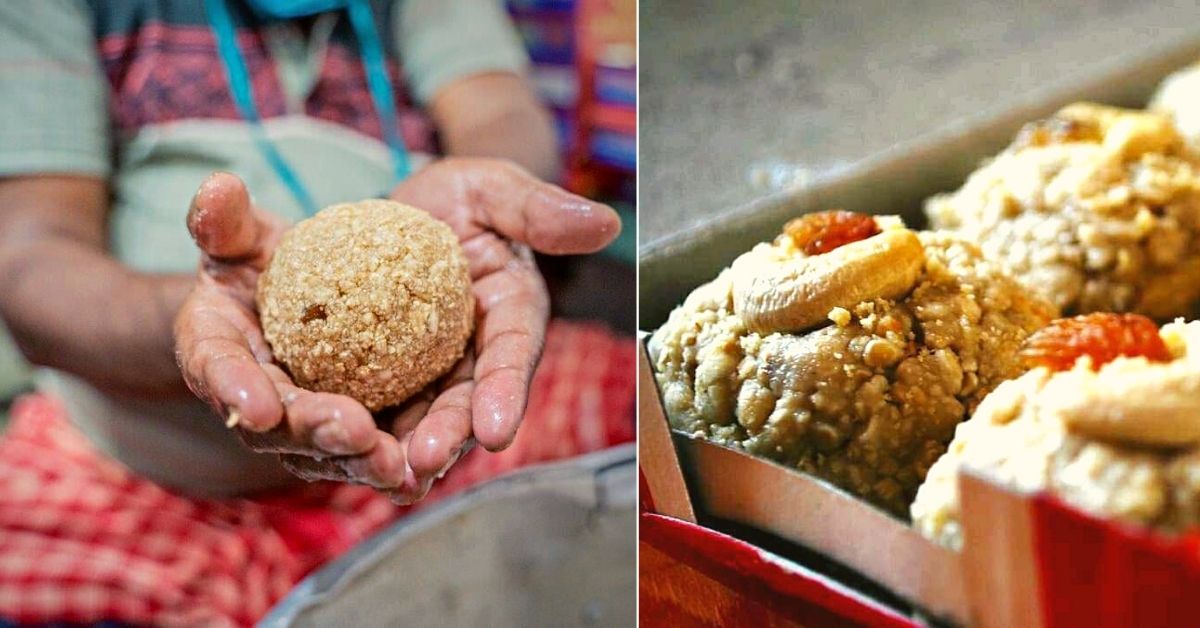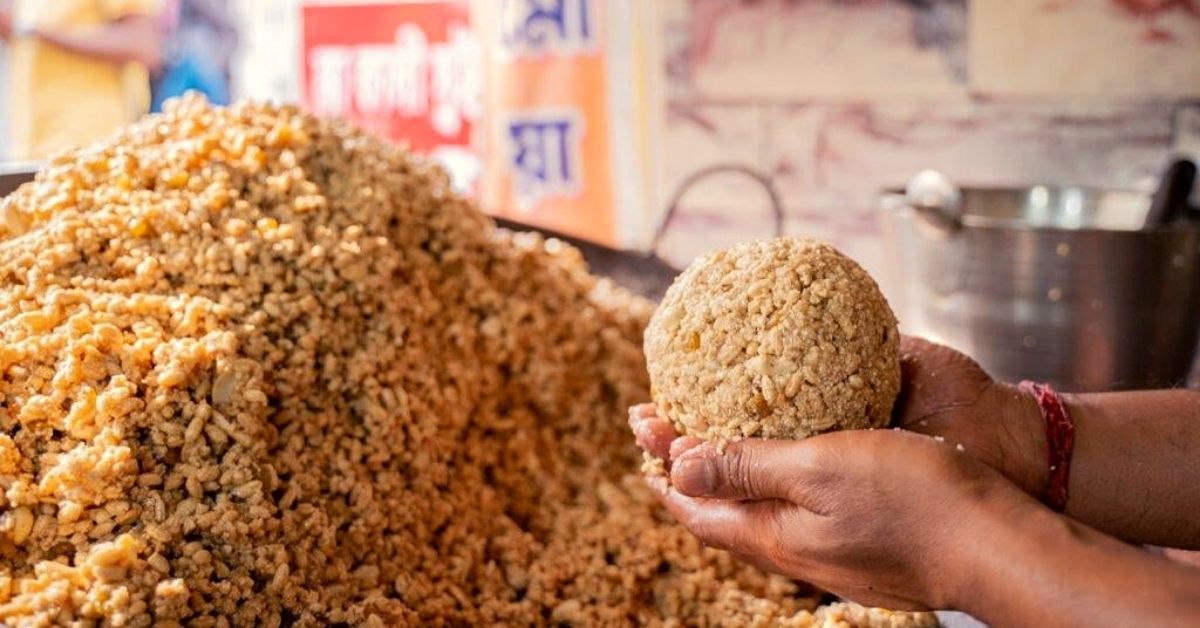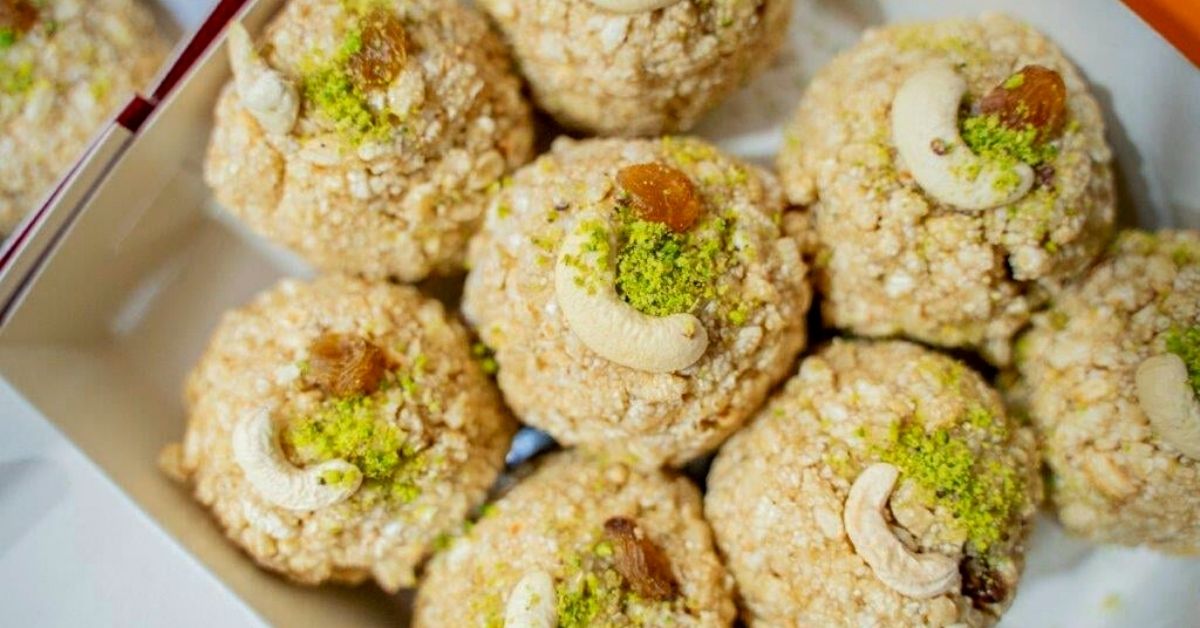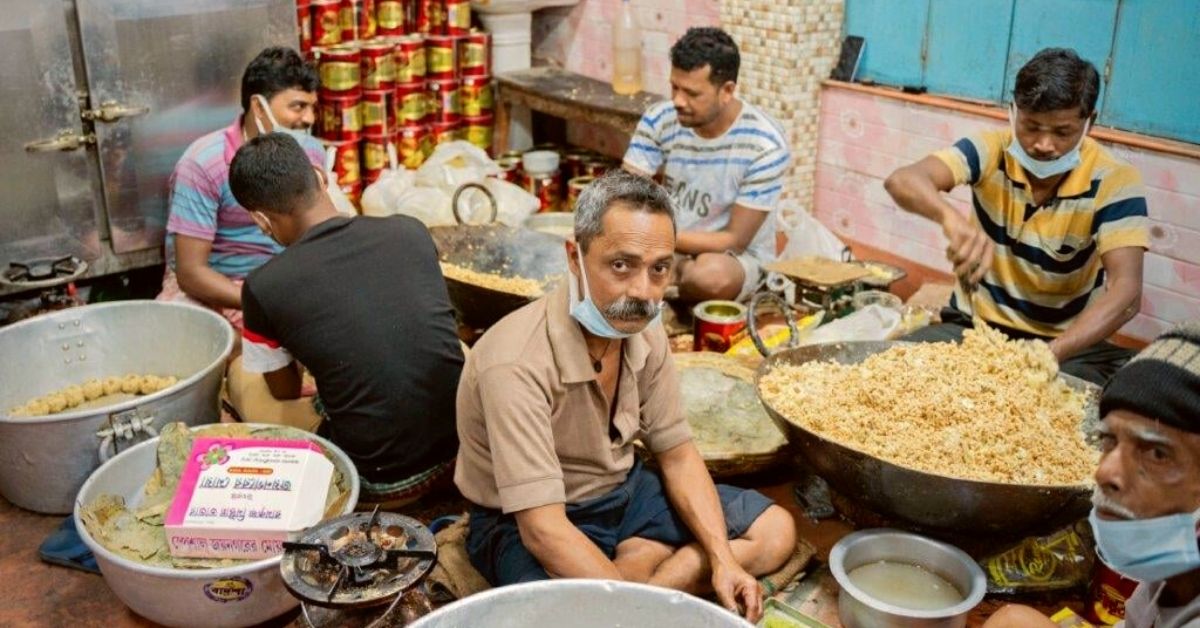Bengal’s Best Kept Secret is This GI Tagged, 118-YO Sweet from a Rural Community
Cheap knock-offs are available all year round. But to get the authentic taste of Joynagar Moa - you have to visit this town in West Bengal.

An antidote of sorts to the cold winter mornings is the smell of deep-fried phulko koraishuti kochuri (puffy peas kachoris) served with spicy aloo dum that wafts through the house welcoming one to the breakfast table.
But the plate of luscious sustenance is still empty without the crown jewels of the season — a bowl full of jhola gur (liquid date palm jaggery syrup) and famous Joynagar Moa, a type of laddu made with jaggery and popped-rice.
A highlight of all winter mornings, Joynagar Moa is a winter delicacy that holds a very special place in a true blue Bengali’s heart. Made with jhola or nolen gur, a special jaggery which is the first flush of juice extracted from the date palm tree, mixed with the native variety of popped rice called Kanakchur khoi and ghee, sugar, khoya kheer, raisins, poppy seeds and cardamom powder, this sweetmeat is a power-packed ball of rich goodness.
However, lately, like most things, even Joynagar Moa is being sold all year round, a practice that most food experts and enthusiasts consider blasphemous.
An expert on the sweetmeat, Ashok Kumar Kayal says, “The reason why this moa has Joyanagar’s name is that the authentic flavour was mastered only by the karigars and sweetmakers of this region and the fresh ingredients found during the season. The other knock-offs that you see all year round often don’t use the authentic ingredients and are unmatchable with the real taste of Joynagar moa.” Today, Ashok runs the Joynagar Moa Nirmankari Society as the founder secretary, based out of Jaynagar Majilpur, West Bengal.
The society ensures the authentic flavour of Joynagar Moa stays alive while empowering over 400 Joynagar Moa makers or ‘karigars’, as Ashok calls them. Clearly, there is more to this sweet than just its taste.
From a common man’s thali to the royal plate

Seat of cultural heritage and Bengal’s liquid gold, the date palm liquid jaggery called jhola or nolen gur, the villages near Jaynagar-Majilpur has been known to house gur-tapper or cultivators for decades. It is this ingredient that forms the core of Joyanagar’s moa in addition to providing a sticky bind for the kanakchur popped rice exterior. A round vessel that magically captures the intoxicating aroma of nolen gur and the fragrant rice, this sweet moa with its luscious bite has been enthralling patrons for hundreds of years.
But before all that, it was moawalla Ashutosh Das, a resident of Das para in Sripur village, Jaynagar block, who invented this gem in 1904. Considered to be a proletariat dessert commonly consumed by the villagers, moa, a form of laddu made with popped rice, back then did not have its present-day elevated status.
This had forced Das to explore business opportunities outside the local market. He would travel to different villages carrying a basketful of moas on his head. For moawallas like him, any village fair, carnival or festival was the peak opportunity for business and on one such occasion, his unique invention of moas made with nolen gur got its first taste of success.

It was during the Radhaballav Dol, a local festival celebrated during Holi, that many dignitaries and prominent personalities of Bengal visited his village. It was during this festival that many got to sample his delicious nolen gur moa and even carried it back as a memento for relatives and friends. Its partially dry exterior helped carry the sweetmeat through long distances, hassle-free and comparatively long shelf life, ensuring that its taste wasn’t compromised even after days of buying. Hence, a sweet that was usually ignored locally soon began to rise in fame amongst the affluent zamindar families. Soon this sweetmeat also began to frequent temples as a form of prasad.
Some accounts also mention that his son, Jawahar Lal Das who carried his father’s legacy used to directly sell Joynagar moas to the family of Rashmoni Das, famously known as Rani Rashmoni, the philanthropist zamindar and businesswoman who founded the iconic Dakshineswar Kali Temple in Kolkata.
Becoming an icon

Owing to its popularity, in 2015, Joynagar Moa received a Geographical Indication (GI) tag enabling it to be protected from unauthorised use or piracy. And the Joynagar Moa Nirmankari Society, which started in 2005 to empower moa-makers of Joynagar, was entrusted with the responsibility of producing and sale of authentic moas, both domestically and internationally.
“It takes over a year for a karigar to get the GI certification done. And so far we have helped a total of 46 of them get this certificate. However, under our cooperative, a total of 429 karigars make Joynagar moas in two varieties-super and super special,” says Ashok. Since the GI tag, orders from countries like the US, UK, Canada and Singapore have been flooding, making the local delicacy go global.
“While we are overwhelmed and happy with the response, we also need to ensure that the moas live up to the authentic standard even when they are exported. For that we are experimenting and exploring ideas to increase its shelf-life through efficient packaging, without compromising on the taste,” adds Ashok.
At a time when age-old recipes and delicacies stand a chance of becoming redundant, efforts like these are making the local sweetmeat, Joynagar Moa and its makers truly immortal.
Featured image sources (L-R): The moa in binding stage ; Joynagar Moa in a box
Sources:
Telegraph
KolkataFirst
Edited by Yoshita Rao

Similar Story

8 Best Idli Places in Bengaluru Which Serve Extra Love For ‘Thatte Idlis’
Larger than the usual idlis and shaped like discs, the ‘thatte idlis’ of Bengaluru have a fan following of their own. Here are eight places in the city for idlis and other South Indian breakfast staples.
Read more >
If you found our stories insightful, informative, or even just enjoyable, we invite you to consider making a voluntary payment to support the work we do at The Better India. Your contribution helps us continue producing quality content that educates, inspires, and drives positive change.
Choose one of the payment options below for your contribution-
By paying for the stories you value, you directly contribute to sustaining our efforts focused on making a difference in the world. Together, let's ensure that impactful stories continue to be told and shared, enriching lives and communities alike.
Thank you for your support. Here are some frequently asked questions you might find helpful to know why you are contributing?


This story made me
-
97
-
121
-
89
-
167












